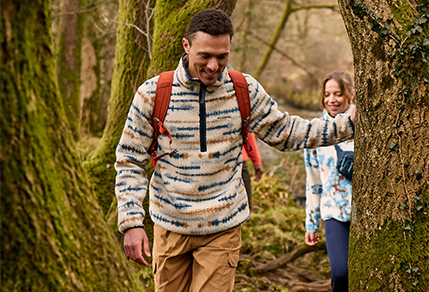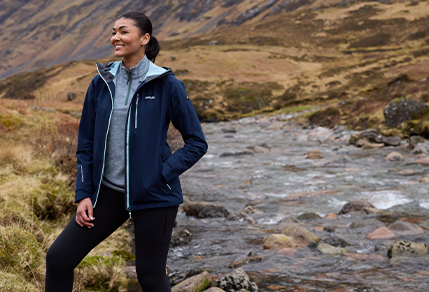The Great Outdoors: Your Guide to Walking, Hiking & Exploring Safely
Posted by Rob Whitchurch on 1st Sep 2025
Climb Every Mountain! Your Guide to Getting Out in the Great Outdoors
Blissful views, fresh air… and zero notifications. But before you lace up, let’s make sure you’re dressed for success and not disaster.
The great outdoors. An open invitation to explore, breathe, and de-stress from the chaos of the modern world. No mobile phone buzzing every 5 minutes with the latest Facebook post from your great aunt about her new Victoria sponge recipe.
Just the sights and sounds of nature. Believe me, there is nothing better.
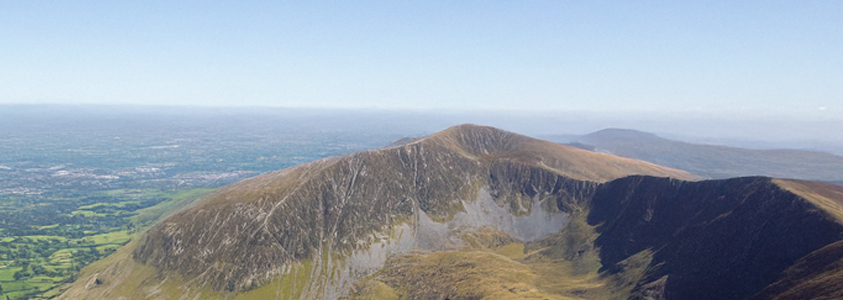
Whether you're walking along the coast path, taking a ramble through the countryside, or tackling a mountain, having the right gear, a bit of know-how, and some hiking smarts makes your walk all the more enjoyable. Plus, let's be honest, we've all heard the stories of people walking up Yr Wyddfa (Snowdon) in Crocs and flip-flops, only to have to be rescued. Don't be that person.
I should point out that walking, in my opinion, is one of the best ways to stay healthy. Forget your cycling, football, swimming, or golf (which spoils a good walk) putting one foot in front of the other, while taking in the calming sights of nature, is one of the best feelings in the world.
Before we dive into making sure you've got all the right gear for your adventure, let's make sure you know what to expect....one does not simply walk up Ben Nevis.
Where Are We? Know Your Route
So, you've decided to go for it and head into the wild unknown. Whether your route takes you through forest trails, rocky climbs, muddy tracks, or well-maintained footpaths (lucky), knowing where you're going and which turns to take can mean getting to your destination safely in one piece, or getting there looking like you just emerged out of the wilderness for the first time in seven years.
It seems trivial, but looking up your route before you set off is walking 101. Certain routes might not be suitable for beginners or may have a higher difficulty than you were expecting. 5 miles of relatively 'flat' terrain is vastly different from 5 miles of 'mountainous' terrain, so it's always best to check what you'll be up against before deciding.
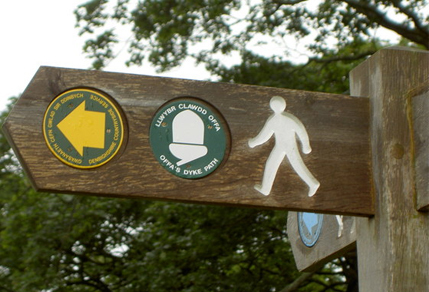
Don't just rely on your phone's generic map app, as the signal can be unreliable, especially in the middle of nowhere, and if it doesn't know where you are, then neither do you. It may seem old school, but having a proper map with you of the area will make navigation that much easier, even if it's just a printout of your walk that you've highlighted.
Yes, most walks will be signposted, but if one's missing, and you've hit a fork in the path, it's best to make sure you pick the right path; otherwise, you're going to end up in the middle of a field with no clue where to go. Nowadays, you can get some great hiking apps that can plot your route with incredible detail, plus they'll tell you which way to go next, and some can even print off the route so you've got a hard copy to hand. Just make sure you've got a power bank or enough phone battery if you decide on this option.
One thing to consider when picking your route is, is it easy to get to? If you're starting your route in a town or village, car parking space won't be much of a problem, however if it's during school holidays, or it's a gloriously sunny weekend, these small car parks might fill up quicker than you expect, so it's always best to have a couple of options to choose from, and don't forget to see if you have to pre-book your space as well, otherwise you might be left disappointed.
The alternative, of course, is public transport (stop sniggering at the back). Yes, it's a well-known joke that you can wait for a bus and then three turn up at once; however, services like the Sherpa’r Wyddfa, which goes around Snowdonia, enable walkers to get about the national parks, and leave the car at home. Most services run on Sundays as well, just make sure to check the timetable so you don't get left behind after the last bus has left.
If you fancy walking along the coast and live in the middle of the country, hopping on a train to get you to your destination is always an option as well, plus, most bus services stop at the train stations in the area, so it's even easier to get to where you want to go.
Obviously, the day you want to go out walking, the weather will be glorious, right? Unfortunately, we live in the UK where the weather is usually, how to put this politely, unpredictable. Check the forecast the night before, as well as in the morning, to see what Mother Nature has in store for you. It might also make up your mind about what kit to bring with you and what to leave at home!
If you've decided to climb a mountain, the weather at the bottom may be vastly different from the top, so it's best to be prepared for anything so you're not caught out.
Finally and most importantly, let someone know where you're going and what time you'll be back. It seems silly, but it can be a lifesaver, especially if you're in a phone signal dead zone. Letting someone know your itinerary with rough estimates of when you'll be back means that if you're not back by the time you've said, the alarm can be raised quicker and potentially save a life.
With the route plotted out, it's time to get your kit together.
This Isn’t a Catwalk: Dress for the Weather, Not Instagram
Hiking isn't a fashion show, so you can leave your Prada shoes and Gucci bag behind, but it's also not a walk in the park either, so I'm afraid even your Vans and Nike trainers won't cut it. The last thing you want is to ruin your favourite pair of shoes or get caught on a bramble bush and end up ripping your best jeans.
Let's start with the most important piece of walking attire....boots. Having a comfortable and sturdy pair of walking boots or walking shoes can mean the difference between a great time and a foot full of blisters. Picking the right boots for your hike will keep your feet happy and you moving forward. If you're planning on a low-level walk through the woods or nature trail, then a pair of low walking shoes will give you the flexibility you need without your feet overheating and feeling heavy.
If, on the other hand, you're going deep into the hills where the gradient is almost vertical, then a pair of walking boots will give you the grip and support you need to make it to the top. Take into consideration the material the boots are made from as well. Leather boots are perfect for wet wintery walks as they'll keep your feet dry and comfortable even if it's lashing down, whereas nubuck or suede boots are more suited to spring and summer, as they'll let your feet breathe, keeping them cool throughout your walk. Just don't forget to break them in.
You may laugh at this next suggestion, but choosing the right socks can make or break a walk. There's nothing worse than overheated feet, and unless you've planned your route to include a quick dip in a lake, hot, sweaty feet can make any hike uncomfortable. Leave the cotton socks at home, as these can hold onto moisture and increase the risk of blisters, which will most definitely ruin your day, and every day afterwards till they heal.
Socks with cushioned heels and toes will keep your feet comfortable underfoot, while pairs with a seamless construction will stop them from rubbing up against your boots and cause hot spots. If you fancy splashing out, a pair of Merino wool socks will help keep your feet cool in summer and warm in winter, so they're perfect for all seasons.
Next stop, walking trousers. Finding a good pair of walking trousers will keep you comfortable as you stride out. If you're heading out during winter, a pair of lined trousers will help keep the chill out and the warmth in, so you won't have to endure cold kneecaps as you make your ascent. On the other hand, if you're more of a bright sunny day kind of walker, then a zip-off pair of trousers is ideal, especially if things get a tad warm, you can quickly convert them into three-quarters or shorts... depending on how brave you feel.
Make sure they've got lots of pockets for all your walking essentials too. If it ‘looks like rain' then making sure they're quick drying and water-resistant is definitely a must, as nobody wants soggy legs, especially when you've still got three miles to go. If the forecast calls for heavy downpours, but when you set off, it's clear skies, packing a pair of overtrousers that you can quickly slip on when the heavens eventually open, will keep you dry until it eventually stops raining.
Layers! While you don't have to be wearing every single item in your wardrobe, making sure you're layering up your attire will keep you comfortable and ready for anything.
Start off with a base layer rather than your favourite t-shirt, as they're better at regulating body temperature, stopping you overheating when you start your climb, plus most have ventilation under the armpits with anti-microbial coating so you won't feel or smell sweaty.
If there's a chill in the air, but it's a clear crisp day, a walking fleece can add that extra bit of warmth, especially if it's got a high collar, as that'll keep the wind at bay.
A more mid-weight fleece will add that little bit of insulation, but if you're set on walking after a night of snow, then opting for a heavyweight or insulated option is going to keep those biting temperatures at bay while you stay warm.
But if it's just a little bit chilly and, you don't fancy a fleece, a bodywarmer will keep your core warm and your arms free as you scramble up those last few rocky outcrops.
Unfortunately, living in Britain means rain is inevitable, so ensuring you've got some sort of waterproof coat or jacket with you is a must. If the heavens have not stopped all day, ensuring your coat has taped seams and a waterproof coating will keep the worst of the weather at bay until you can find some sort of shelter.
Ensuring you've got good ventilation will keep you comfortable throughout your walk as well. On the other hand, if there's not a cloud in sight but rain 'is forecast' having a packable jacket can mean the difference between being ready for anything and being soaked. These packable jackets can easily slip into your backpack without taking up much space, and if it's not going to rain, you can use it as a ground sheet when it's time for a quick stop.
Finally, let's look at accessories. The classic hat & gloves combo is easy to stow away in pockets, and if you've grabbed a pair of waterproof gloves, your hands will thank you. While a cosy long scarf may seem like a good idea, it's maybe not so fun when it gets tangled around your backpack and is slightly strangling you.
A neck gaiter or snood can be simply stuffed in a pocket and popped on when the wind picks up; you can even use it as a head covering when it's too warm for a full-blown beanie. If there's a small stream blocking your path, and you don't really fancy trying your best long jump attempt, a pair of leg gaiters can simply be pulled on over your trousers and will stop water from seeping into your boots, because nobody wants wet feet.
So now we've sorted out your new walking wardrobe, let's take a look at what gear to bring with you!
Pack Like a Pro, Not a Pack Mule
While you don't have to bring the kitchen sink with you, having a few essentials with you will ensure you're prepared for anything. A good-sized daypack will have enough room for all the essentials without weighing you down, but if you're tackling longer and more challenging walks then, a walking rucksack is best.
A waterproof liner in the rucksack will help keep everything dry, but if you want to be extra sure, popping everything in separate drybags will protect them, plus if you get different colours, you can easily organise all your gear; from won't need till later, to need as soon a possible.
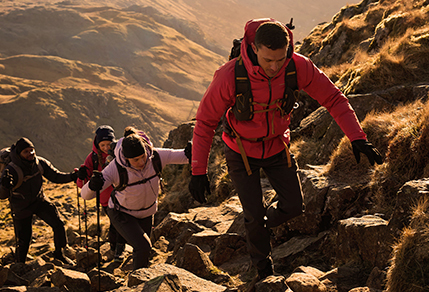
It goes without saying that you'll need food and water. Hydration is key, so a good-sized water bottle is a must, but if you don't fancy having to reach around for your bottle, then opting for a bladder/reservoir is a good choice.
These can easily slip into your rucksack as well without taking up too much space. Most rucksacks have a hole to feed the tube through, so you can always have it on hand if you feel thirsty. If your reservoir runs dry, and you need to fill it up, make sure you've got some water purification tablets to hand so you can safely refill your bottle without the risk of becoming ill.
Snacks are a must as these will keep your energy levels up as you progress on your walk. Energy bars, fruit, sweets or, a classic Kendal mint cake will keep your spirits high and your energy levels topped up, ensuring you get to the summit with no issues
For those out a little bit longer or who are wild camping, grabbing a few travel meals that can easily be rehydrated is ideal. They're specifically designed for walkers and can be heated up or eaten cold (if you're feeling brave). A little compact camping stove can be easily slipped into your rucksack and be ready in minutes.
When the going gets tough, the tough grab a walking pole, especially if the terrain is a little bit treacherous. Having that little bit of stability can mean the difference between getting up the slope in one piece and sliding back down to the bottom and having to have another go.
But if you're heading out after a substantial snowfall, then don't forget to pack the crampons and ice axe to give you that bit more stability. If you're caught out late at night, or you want to catch the sunrise at the top, grab a small pocket torch to light your way or to consult the map. Grab a head torch for a hands-free option. Plus, both are ideal to signal for help if you get stuck.
Speaking of getting stuck, if the worst happens, and you need help or one of your fellow walkers does, having a small first aid kit to hand can help treat the minor injuries and cuts. Most walking first aid kits also have a survival bag in them that you can use as a temporary shelter until help arrives. Check if it comes with a whistle for attracting attention, too, so it's easier for rescuers to find you. Oh, and if you fancy walking in the height of summer or, you're heading to Scotland, be sure to carry bug spray to keep those midges at bay.
So, the route's planned, the rucksacks packed, and you've got all the gear. It's time to de-stress, put the screen away, and head out into the great outdoors. Remember to leave no trace behind, close all gates behind you, and if things do go wrong, which they won't, don't be afraid to ask for help from Mountain Rescue.
But most importantly, enjoy yourself. I'll see you out there!
The Great Outdoors, Demystified
Ready to hit the trail? Before you lace up your boots and stride into the wild, let’s clear up some of the big questions hikers often have.
How Do I Break In Walking Boots?
Don't immediately hit the 10-mile trails. Start on smaller walks with flat terrain to gradually wear them in. You can also wear them around the house with your walking socks on to help break them in.
Pro Tip: If you feel a hotspot developing, stop immediately, adjust your boots, and stick a blister plaster on before it turns into a problem.
How Do I Clean My Walking Boots?
Clean boots equal a lifetime of walking with happy, dry feet.
- Remove any mud and debris from your boots after every walk with a soft brush and warm water. Don't forget to take your insoles out and let them dry naturally
- Once your boots are clean, let them dry naturally away from heat sources, as this can cause damage to the waterproof membrane and can cause leather to crack.
- Apply a reproofing spray or wax to keep them waterproof and ready for your next adventure.
How Can I Avoid Blisters?
There's nothing worse than blisters. But they are avoidable!
- Break your boots in first and ensure they're a perfect fit. Don't go from shopfloor to summit straight away
- Wear moisture-wicking socks to reduce your feet from sweating
- Keep your feet clean and dry
- Use blister pads or tape on hotspots before they become an issue.
How Do I Re-proof My Coat?
If you start to feel a bit more damp than usual, then it might be time to reproof you're coat.
- Wash it with a tech-friendly cleaner to clear out any stubborn stains and dirt.
- While still in the washing machine, use a reproofer to reactivate the coating
- Allow to dry naturally, and you're all set.
Always read the label first before attempting to reproof your garments.
How Do I Pack My Rucksack?
While you won't be carrying everything you own, packing the right way can make your walk more enjoyable and prevent you from having to empty it every time you need something.
Bottom: Sleeping bag, spare clothes, and bulky soft kit.
Middle: Heavy items like water bottles, food, and cooking gear (close to your spine for balance).
Top: Waterproofs, snacks, map, compass, and anything you’ll need on the go.
Side Pockets: Water, trekking poles, or extra layers.
Hip Belt: Snacks, lip balm, or your phone — keep the essentials handy!
Pro Tip: Use drybags or pack liners to separate wet and dry kit — and avoid the dreaded soggy socks.
How Much Water Should I Bring With Me?
It depends on the walk, but here’s a good rule of thumb:
Short hikes (under 2 hours): 500ml–1L
Medium hikes (2–5 hours): 1.5L–2L
Long hikes (5+ hours): 2L+ plus a refill option
Pro Tip: A hydration bladder makes sipping little and often easier. For longer hikes, consider bringing water purification tablets or a filter bottle so you can safely top up from streams.
What’s The Safest Way To Plan A Hike If I’ve Never Used A Map Before?
If navigation isn’t your strong point, start simple:
- Pick a beginner-friendly, well-marked route to build confidence.
- Use a hiking app like OS Maps, Komoot, or AllTrails and download your map offline.
- Carry a printed route as a backup — yes, old-school, but reliable.
- Check reviews to see if paths are clear and signposted.
- If you want to improve, practice basic map-reading skills at home — learn symbols, paths, and contour lines.
Pro-Tip Start with looped/circular walks — easier navigation, fewer “where am I?” moments.





